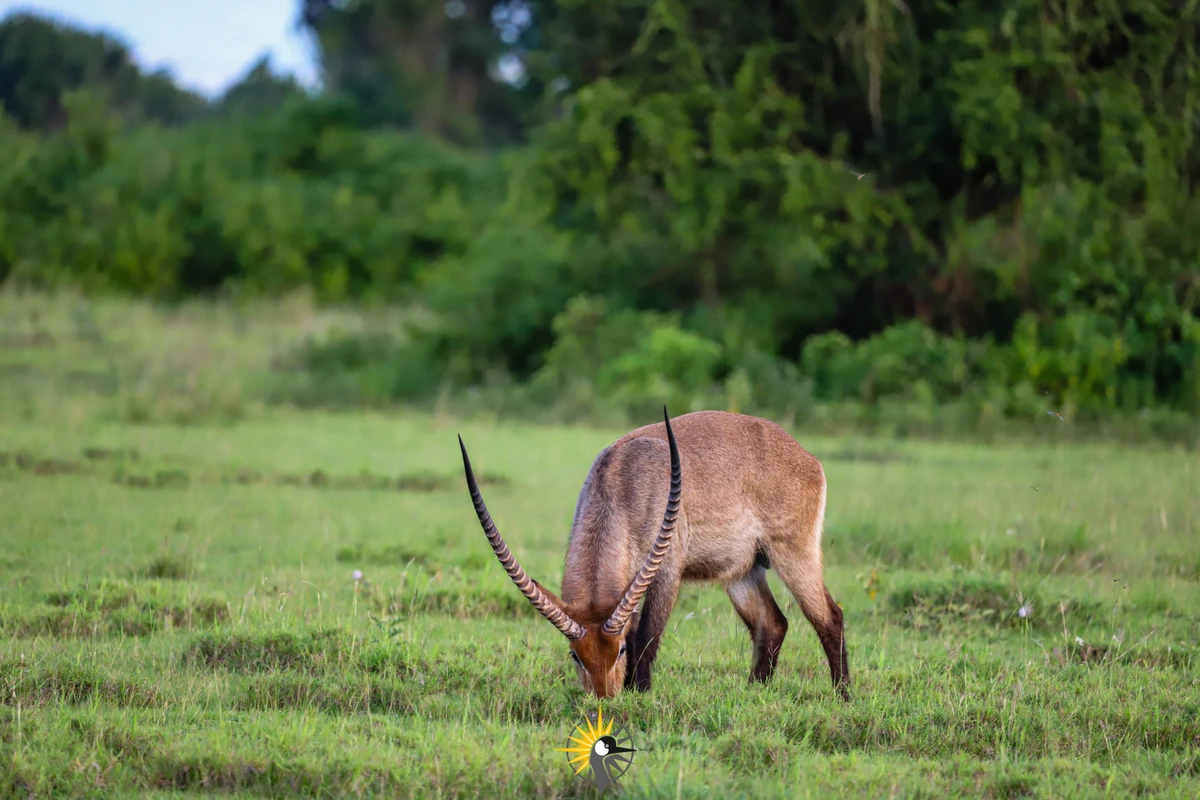The waterbuck is one of Africa’s most striking and resilient antelopes. Found across sub-Saharan Africa, this species captivates wildlife enthusiasts with its distinctive appearance, fascinating behaviors, and strong connection to water. Whether you’re on a safari or exploring the animal’s role in its ecosystem, the waterbuck offers a compelling story of survival and adaptation.
A striking and unique antelope
Waterbucks are instantly recognizable among Africa’s diverse wildlife. They have a stocky build, standing up to 1.4 meters (4.5 feet) tall at the shoulder. Males weigh between 200 to 300 kilograms (440 to 660 pounds), while females are slightly smaller, but both sexes are robust and muscular.
Their shaggy coats, ranging from grayish-brown to reddish-brown, give them a distinctive look, especially when paired with the white markings around their eyes, mouths, and the iconic white ring on their rumps. The coat is not just for show—it contains an oily secretion that makes it water-resistant, a critical adaptation for their semi-aquatic lifestyle. This oily coat, however, also gives them a strong musky odor, which can make them less appealing to predators.
Male waterbucks boast impressive, ridged horns that curve backward and then forward. These horns, which can grow up to 1 meter (3 feet) long, are used in territorial battles and are a defining feature of the species. Females, by contrast, lack horns but possess the same graceful appearance.
Habitat
True to their name, waterbucks are almost always found near water sources such as rivers, lakes, swamps, or floodplains. Unlike other antelopes, they are heavily dependent on water for both survival and protection. They drink regularly, making them vulnerable to dehydration if separated from their preferred habitats.
Waterbucks also use water as a refuge from predators. When threatened, they often retreat into rivers or swamps, where they can use their strong swimming abilities to escape danger. However, they are versatile and can thrive in savannahs and woodlands, provided that these areas have access to reliable water sources.
Behavior and social dynamics
Waterbucks are social animals, though their group structures differ between males and females. Female waterbucks live in loose herds that can range from a few individuals to as many as 30 members. These herds are generally composed of females and their offspring, offering protection and companionship.
Males, on the other hand, are solitary and territorial. They establish and defend territories that are rich in resources, such as grass and water, to attract females. Territorial males patrol their domains regularly and are prepared to fight off rivals. Battles between males are intense but rarely fatal, with their powerful horns clashing in displays of strength and dominance.
Waterbucks are also vigilant and alert, relying on their sharp senses to detect predators. They communicate through vocalizations, body language, and scent marking to maintain their territories and warn of potential threats.
Diet
As grazers, waterbucks primarily feed on grasses, although they may occasionally browse shrubs and leaves when grass is scarce. Their diet is closely tied to their habitat, as they prefer areas with lush vegetation. By feeding on grasses, waterbucks help maintain the balance of their ecosystems, ensuring that vegetation does not grow unchecked. This, in turn, benefits other herbivores that share the same environment.
Their grazing habits also support the health of their habitats by preventing overgrowth and promoting biodiversity, making waterbucks an essential part of their ecosystems.
Natural predators and survival tactics
Waterbucks face threats from several predators, including lions, leopards, hyenas, and crocodiles. Their strong build, sharp senses, and strategic use of water give them an edge in evading predators. For instance, their oily coats can make them slippery and harder for predators to grip, while their ability to swim allows them to escape into water where many predators hesitate to follow.
Despite these defenses, young calves and weaker individuals remain vulnerable. Mothers are particularly protective of their young, often hiding them in dense vegetation to shield them from danger.
Observing waterbucks in the wild
For wildlife enthusiasts and safari-goers, waterbucks are a must-see. Their calm demeanor, coupled with their striking appearance, makes them an excellent subject for wildlife photography. Watching them graze along riverbanks or retreat into water is a mesmerizing experience that reflects their connection to their environment.
In East Africa, popular destinations for spotting waterbucks include Uganda's Queen Elizabeth National Park, Murchison Falls National Park, and Lake Mburo National Park. Kenya’s Maasai Mara and Amboseli National Parks, as well as Tanzania’s Serengeti and Tarangire National Parks, also host thriving populations of waterbucks.
Conservation status
The International Union for Conservation of Nature (IUCN) lists the waterbuck as a species of Least Concern, thanks to its widespread population and adaptability. However, like many wildlife species, waterbucks face localized threats from habitat loss, human encroachment, and poaching.
Conservation initiatives across Africa focus on preserving habitats, combating poaching, and promoting sustainable tourism. Efforts to establish and maintain protected areas have been instrumental in ensuring the survival of waterbuck populations. Eco-tourism, including guided safaris, provides critical funding and awareness for these conservation programs.
A symbol of African eesilience
Waterbucks embody the strength and adaptability of Africa’s wildlife. Their reliance on water and their remarkable survival strategies highlight the delicate balance between animals and their ecosystems. For tourists and wildlife enthusiasts, encountering a waterbuck in the wild is a vivid reminder of the beauty and complexity of nature.
Planning a safari? Witnessing waterbucks in their natural habitat is an unforgettable experience. Whether you’re a seasoned traveler or a first-time explorer, these elegant antelopes will leave you in awe of Africa’s diverse and breathtaking wildlife. Let us help you design the perfect safari adventure, complete with close encounters with waterbucks and other iconic animals!









